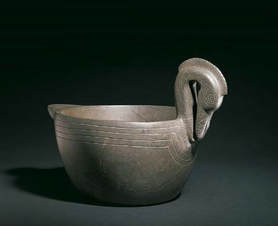 (Courtesy Moundville Archaeological Park)
(Courtesy Moundville Archaeological Park) Shortly after it was discovered, the Moundville Duck Bowl created a national stir when Harper’s Magazine, the most popular magazine in the United States, published a major feature story in January 1906 on the excavations at Moundville. The article, authored by Moore’s laboratory assistant, Harriet Newell Wardle, described the bowl as “the most remarkable piece of sculpture ever discovered north of Mexico on the American continent.... This is the find that has set the archaeological world agog—an absolutely unique piece, beautiful in its workmanship and in the symmetry of its form.”
Sculpted out of a single massive piece of stone, its creator adorned the rim of the elegant bowl with the graceful neck and head of what appears to be a supernatural bird creature.
Though it has been long absent, today the national treasure, along with fifty other significant Moundville pieces, has returned on loan to the state archaeological park. The items are on exhibit at the Jones Museum (reopened after a five-million-dollar renovation and expansion) at the University of Alabama’s Moundville Archaeological Park. Gaining approval for the loan of the Duck Bowl and the other Moundville treasures from the Smithsonian Institution’s National Museum of the American Indian (NMAI) was no easy task. Several trips were made to Washington, DC, to present exhibition plans and to select proposed objects for loan. Throughout the design phase, conservators at the NMAI reviewed all drawings and specifications for the artifact case and security, along with temperature and humidity controls. In the final hour before exhibit production began, however, the Duck Bowl was nearly removed from the loan because NMAI curators wanted to exhibit it at their branch museum in New York.
Recognizing the importance of this particular artifact to the planned exhibition storyline, Moundville Archaeological Park turned to its constituency of Native Americans and scholars for support. Chiefs of southeastern tribes in Alabama, Mississippi, and Oklahoma, along with a number of respected archaeologists, wrote letters of support requesting that the Duck Bowl be exhibited at Moundville. Thankfully, the loan was approved and thousands of park visitors, including hundreds of Native Americans, have enjoyed seeing this spectacular piece at the site of its origin. In addition, staff from the Smithsonian Institution have visited the exhibition and have been thrilled with the way in which these objects are presented. The Smithsonian recently renewed the loan for the Duck Bowl through September of 2011, providing Alabamians an extended opportunity to visit one of the most valuable and impressive prehistoric relics ever discovered in their state.
This feature was previously published in Issue 100, Spring 2011.
Author
Bill Bomar is the director of the University of Alabama’s Moundville Archaeological Park and Museum. He has worked in museums and heritage sites for over twenty years and teaches museum studies as an adjunct professor at the University of Alabama.
 RSS Feed
RSS Feed